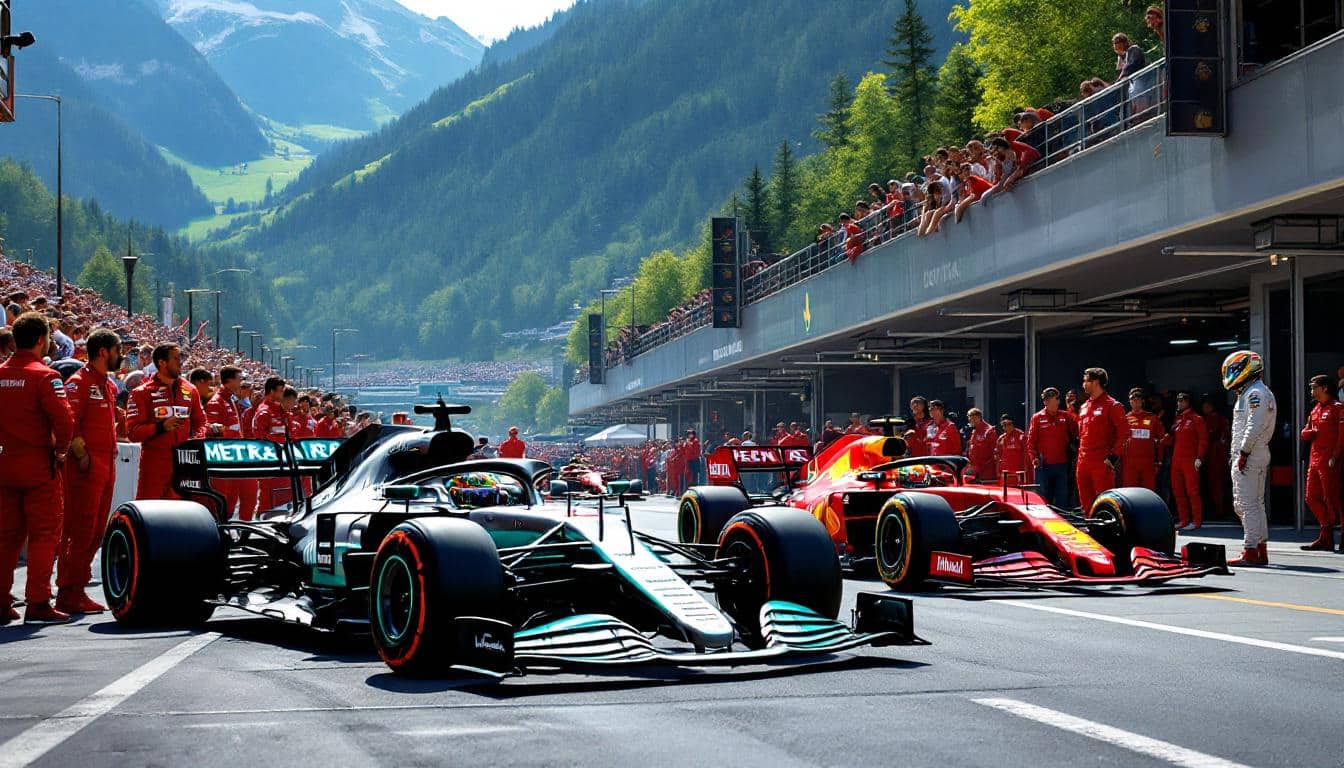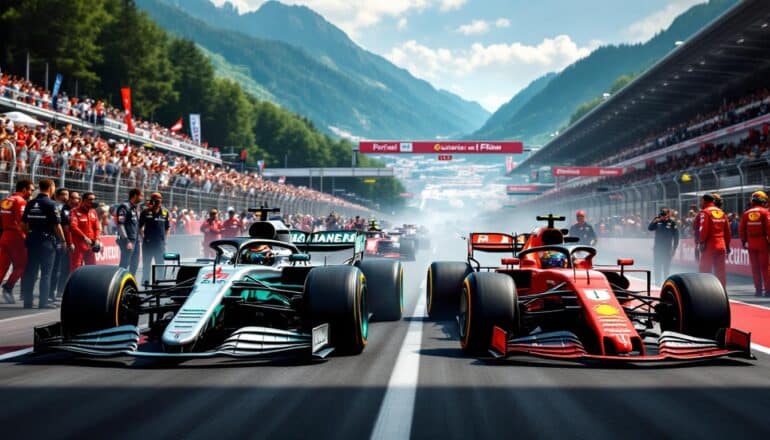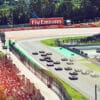As the engines roared and tires screeched at the Austrian Grand Prix, the drama unfolded once more on the asphalt stage of Formula 1. With each lap, the tension thickened, leaving fans on the edge of their seats, eager to witness how teams would adapt and excel. Amidst the action, a hint of progress emerged from the Ferrari camp, stirring excitement for the Scuderia’s fervent supporters.
Charles Leclerc claimed a spot on the podium, showcasing hints of former glory, while Lewis Hamilton made strides of his own, finishing in a respectable fourth place. Despite ups and downs throughout the weekend, both drivers highlighted important developments in their performances. The thrill of competition brought energy, with fans eagerly anticipating the upcoming races as the world of motorsport continued to evolve in the face of challenges. As strategies and setups are refined in this high-stakes arena, the question remains: how will the results of this weekend shape the future of these iconic teams?

The challenging world of Formula 1 saw a notable shift during the recent Austrian Grand Prix. Lewis Hamilton, the illustrious driver for Mercedes, found himself navigating a series of brake issues that affected his overall performance yet hinted at a significant evolution in his approach to the track. As he edged closer to the setup favored by Charles Leclerc and his Ferrari team, fans and enthusiasts alike tuned in to witness how their contrasting styles might converge on the track.
The Austrian Grand Prix unfolded with Hamilton finishing fourth, showcasing his competitive spirit against a backdrop of mechanical complications. His performance was juxtaposed with that of Leclerc, who claimed a podium finish, creating an intriguing narrative that fans would dissect. This race served as a pivotal point for Hamilton as he reflected on the nuances of his vehicle’s handling and how it aligns with the Ferrari setup, especially in the face of *brake challenges* that dampened his potential for a higher finish.
Within the high-octane ambiance of F1 racing, such technical difficulties often define the outcomes of races. Hamilton’s reflections on the specific brake issues reveal the delicate balance drivers must strike between performance and reliability. As he described, “We have brake issues, so I had to manage these brakes pretty early on, which was losing definitely some time.” This acknowledgment of *brake management* showcases not only Hamilton’s proficiency in handling adversity but also highlights the broader context of mechanical engineering that underpins each race.
Yet, it is not merely a tale of setback. The movement toward a more compatible setup with Leclerc offers a glimpse into Hamilton’s adaptability. Leclerc’s car, designed for greater oversteering capability, had proved effective, allowing him to maintain pace without compromising on degradation. This aspect of racing strategy is crucial, as it gives teams insights into potential upgrades or changes they might implement moving forward.
What do Hamilton’s brake issues mean for Mercedes’ performance?
The recurring brake issues faced by Hamilton pose critical questions about Mercedes’ overall performance this season. As he openly discussed these troubles after the race, it became clear that they were detrimental not just to his lap times, but also to his ability to compete closely with formidable rivals like Leclerc. Such mechanical setbacks underline the challenges faced by teams when they strive for the pinnacle of performance while adhering to FIA regulations.
The performance of brakes is quintessential in Formula 1; they are not just components but vital elements that dictate a car’s speed, handling, and tire preservation. Hamilton previously likened his braking system to “a lottery,” reflecting the inherent risks and unpredictability associated with his current setup. As he notes, “We roll the dice and you put one [set of brakes] on and it works, and you put another on and it doesn’t.” This metaphor illustrates the precarious nature of innovation in F1, where mere components can significantly influence race outcomes.
Hans Meyer, head of engineering at Mercedes, pointed out that optimizing brake systems isn’t just about replacing parts but rather understanding how those components interact with the entire car. “To improve our braking, we need to analyze data from every telemetry readout,” Meyer stated at a recent engineering summit. This suggests that the focus will not only be on immediate repairs but on a broader strategy to enhance performance through understanding the car’s behavior in various setups.
As Hamilton navigates these challenges, the question of what this indicates for Mercedes persists. The fourth place finish may not reflect the team’s ambitions, yet it does provide a realistic foundation to build upon for future races. Moreover, Hamilton’s candidness about his issues might facilitate a united front in addressing concerns that hinder overall performance.
How does Hamilton’s setup approach evolve alongside Ferrari’s strategies?
Hamilton’s strategic evolution in his approach to car setup is becoming increasingly evident as he begins to parallel the configurations used by Leclerc. The essence of racing is adaptability, and it’s fascinating to observe how rivals can borrow strategies from one another. Hamilton commented on his adjustments: “Set-up even closer to Charles, yeah. He drives a massively oversteering car… When I slide the rear, I get massive degradation.”
The juxtaposition of both drivers’ setups raises questions about team dynamics and collaboration, even among rivals. As that close relationship between drivers emerges, it heightens the stakes in the quest for supremacy on the grid. Hamilton’s acknowledgment of adapting to Leclerc’s setup indicates a broader strategy both drivers deploy, where learning from one another’s approaches could prove beneficial in enhancing overall performance.
Moreover, the significance of collaboration in the midst of fierce competition could reshape the future approaches of both teams. Insights derived from each other’s setups can lead to beneficial exchanges, manifesting in more effective designs or changes that resonate with the distinctive racing styles of each driver. Perhaps this is a microcosm of how Formula 1 works as a whole; driven by rivalry but also reliant on technical exchange between teams.
Despite oversteering challenges, which Nash, a performance analyst, terms as “a double-edged sword,” the implications for Mercedes’ future fixtures could be profound. Hamilton is tasked with mastering a setup that may not come naturally to him while also wrestling with the limitations posed by brake problems. Nonetheless, if he can blend these strategies effectively, Mercedes clamors for a chance to contest for podium finishes at upcoming races.
What are the implications of Hamilton’s perspective heading into Silverstone?
As Hamilton sets his sights on the forthcoming race at Silverstone, there’s a palpable shift in his mindset following the Austrian GP. Despite facing setbacks, there exists an optimistic outlook evidenced by his thoughts post-race: “I think we’ve moved forwards.” This reflective attitude is central to the ethos of a competitor like Hamilton, exemplifying how a driver can leverage experiences, no matter how frustrating, into growth and progress.
The excitement of returning to Silverstone, his home Grand Prix, only augments the stakes for Hamilton. Given the iconic status of the race and the fervent support from British fans, it’s an opportunity to capitalize on newfound insights and drive his team forward. Conclusively, Hamilton’s efficacy in resolving brake inconsistencies while fine-tuning his car’s setup could redefine how he approaches the Silverstone circuit.
Moreover, the recent improvements observed, albeit slight, imply that momentum is building. Hamilton stated about the race upgrades that “the upgrade was quite small, so we didn’t really know… but I think perhaps it was a bigger result from putting the floor on.” This bodes well for the future and confirms that incremental changes are impacting performance positively.
With the future still uncertain and tight competition looming ahead, it’s crucial for Hamilton to act decisively. The pressure is mounting, but the possibility of progress provides a refreshing catalyst for his ambitions. Racing in a place laden with memories, Hamilton is intent on redirecting criticisms toward constructive outcomes.
Through his evolving setup and ongoing challenges, what remains apparent is the indomitable spirit of competition — a hallmark of both Hamilton’s and Leclerc’s careers. In an arena where every second counts, the pursuit of excellence continues relentlessly.


